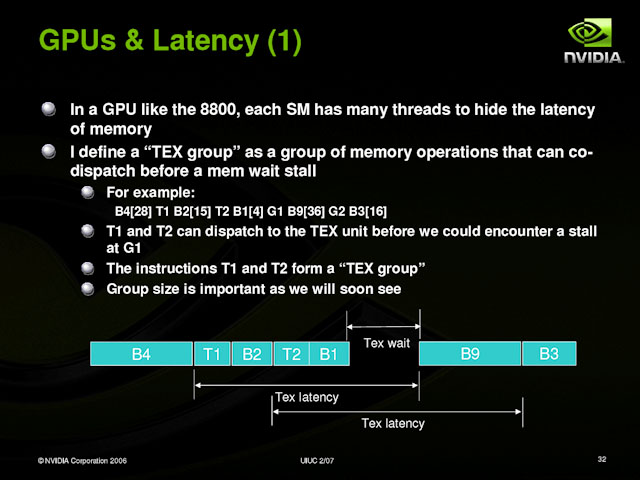Shader stats:
RS Instructions: 8
TEX Instructions: 7
ALU Instructions: 52
ALU Instruction slots: 52
CF Instructions: 0
Pix Size: 12
Highest Const: 31
Start Addr: 0
End Addr: 58
RS Instructions:
rs 00: r00.rg-- = txc00
rs 01: r01.rg-- = txc01
rs 02: r02.rgba = txc02 adjusted
rs 03: r03.rgb- = txc03
rs 04: r04.rgb- = txc04
rs 05: r05.rgb- = txc05
rs 06: r06.rgb- = txc06
rs 07: r07.rgb- = txc07 adjusted
US Program:
0 tex 00 : r01.rgb_ = lookup(r01.rgrr, tex01) ign_unc
1 tex 01 : r00.rgba = lookup(r00.rgrr, tex00) ign_unc
2 tex 02 : r07.rgb_ = lookup(r07.rgbr, tex03) sem_wait sem_grab ign_unc
3 alu 00 rgb: r08.--b = dp3(r04.rgb, r04.rgb)
alpha: r01.a = clamped mad(r02.a, 1.0, 0.0)
4 alu 01 rgb: r08.--b = dp3(r03.rgb, r03.rgb)
alpha: r02.a = rsq(abs(r08.b))
5 alu 02 rgb: r08.r-- = dp3(r05.rgb, r05.rgb)
alpha: r03.a = rsq(abs(r08.b))
6 alu 03 rgb: r08.-g- = dp3(r06.rgb, r06.rgb)
alpha: r04.a = rsq(abs(r08.r))
7 alu 04 rgb: r08.rgb = mad(r01.rgb, 1.0, c11.rrr)*2 sem_wait
alpha: r05.a = rsq(abs(r08.g))
8 alu 05 pre: srcp.rgb = 1.0-2.0*r01.rgb
8 alu 05 rgb: r01.rgb = cmp(neg(srcp.rgb), r08.rgb, nab(c10.rrr))
alpha: r06.a = rcp(r02.a)
9 alu 06 rgb: r08.rg- = mad(r06.a0.0r, c01.g0.00.0, (+2.5000000E-01).0.0ar)
alpha: r06.a = rcp(r03.a)
10 alu 07 rgb: r09.rg- = mad(r06.a0.0r, c01.r0.00.0, (+2.5000000E-01).0.0ar)
alpha: r06.a = rcp(r04.a)
11 alu 08 rgb: r10.rg- = mad(r06.a0.0r, c01.b0.00.0, (+2.5000000E-01).0.0ar)
alpha: r06.a = rcp(r05.a)
12 alu 09 rgb: r11.rg- = mad(r06.a0.0r, c01.a0.0r, (+2.5000000E-01).0.0ar)
alpha: r06.a = mad(r01.b, r01.b, 0.0)
13 tex 03 : r08.r___ = lookup(r08.rgrr, tex02) alu_wait ign_unc
14 tex 04 : r09.r___ = lookup(r09.rgrr, tex02) ign_unc
15 tex 05 : r10.r___ = lookup(r10.rgrr, tex02) ign_unc
16 tex 06 : r11.rrr_ = lookup(r11.rgrr, tex02) sem_wait sem_grab ign_unc
17 alu 10 rgb: r12.r-- = d2a(r01.rg0.0, r01.rg0.0, r06.rra)
alpha: r06.a = mad(r02.b, r02.b, 0.0)
18 alu 11 rgb: r04.rgb = mad(r04.rgb, r02.aaa, 0.0)
alpha: r02.a = rsq(r12.r)
19 alu 12 rgb: r01.rgb = mad(r01.rgb, r02.aaa, 0.0)
alpha: r02.a = mad(r02.g, r02.g, r06.a)
20 alu 13 rgb: r08.-g- = dp3(r04.rgb, r01.rgb)*2
alpha: r02.a = mad(r02.r, r02.r, r02.a)
21 alu 14 rgb: r03.rgb = mad(r03.rgb, r03.aaa, 0.0)
alpha: r02.a = rsq(r02.a)
22 alu 15 rgb: r04.rgb = mad(r01.rgb, r08.ggg, neg(r04.rgb))
alpha: r03.a = clamped mad(r08.g, 1.0, 0.0)/2
23 alu 16 rgb: r02.rgb = mad(r02.rgb, r02.aaa, 0.0) sem_wait
alpha: r02.a = mad(r08.r, r03.a, 0.0)*2
24 alu 17 rgb: r08.-g- = dp3(r01.rgb, r03.rgb)*2
alpha: mad(0.0, 0.0, 0.0)
25 alu 18 rgb: r05.rgb = mad(r05.rgb, r04.aaa, 0.0)
alpha: r03.a = clamped mad(r08.g, 1.0, 0.0)/2
26 alu 19 rgb: r04.r-- = clamped dp3(r04.rgb, r02.rgb)
alpha: mad(0.0, 0.0, 0.0)
27 alu 20 rgb: r03.rgb = mad(r01.rgb, r08.ggg, neg(r03.rgb))
alpha: mad(0.0, 0.0, 0.0)
28 alu 21 rgb: r08.--b = dp3(r01.rgb, r05.rgb)*2
alpha: r06.a = ln2(r04.r)
29 alu 22 rgb: r04.rgb = mad(r06.rgb, r05.aaa, 0.0)
alpha: r04.a = mad(r06.a, c14.r, 0.0)
30 alu 23 rgb: r03.--b = clamped dp3(r02.rgb, r03.rgb)
alpha: r04.a = ex2(r04.a)*2
31 alu 24 rgb: r05.rgb = mad(r01.rgb, r08.bbb, neg(r05.rgb))
alpha: r04.a = mad(r08.r, r04.a, 0.0)
32 alu 25 rgb: r03.r-- = dp3(r01.rgb, r04.rgb)*2
alpha: r05.a = ln2(r03.b)
33 alu 26 rgb: r03.--b = clamped dp3(r02.rgb, r05.rgb)
alpha: r07.a = mad(r05.a, c14.r, 0.0)
34 alu 27 rgb: r01.rgb = mad(r01.rgb, r03.rrr, neg(r04.rgb))
alpha: r11.a = ln2(r03.b)
35 alu 28 rgb: r03.--b = clamped dp3(r02.rgb, r01.rgb)
alpha: r07.a = ex2(r07.a)
36 alu 29 rgb: r01.rgb = mad(r00.rgb, c03.rgb, 0.0)
alpha: r11.a = mad(r11.a, c14.r, 0.0)
37 alu 30 rgb: r02.rgb = mad(r00.rgb, r03.aaa, 0.0)
alpha: r03.a = clamped mad(r08.b, 1.0, 0.0)/2
38 alu 31 rgb: r01.rgb = mad(r02.aaa, r01.rgb, 0.0)
alpha: r02.a = ln2(r03.b)
39 alu 32 rgb: r02.rgb = mad(r02.rgb, c02.rgb, 0.0)*2
alpha: r09.a = mad(r04.a, r00.a, 0.0)
40 alu 33 rgb: r04.rgb = mad(r00.rgb, r03.aaa, 0.0)
alpha: r04.a = mad(r09.r, r07.a, 0.0)
41 alu 34 rgb: r05.rgb = mad(c07.rgb, r09.aaa, 0.0)
alpha: r05.a = ex2(r11.a)
42 alu 35 rgb: r06.rgb = mad(c06.rgb, r04.aaa, 0.0)*2
alpha: r02.a = mad(r02.a, c14.r, 0.0)
43 alu 36 rgb: r01.rgb = mad(r09.rrr, r02.rgb, r01.rgb)
alpha: r04.a = ex2(r02.a)
44 alu 37 rgb: r04.rgb = mad(r04.rgb, c04.rgb, 0.0)*2
alpha: r06.a = clamped mad(r03.r, 1.0, 0.0)/2
45 alu 38 rgb: r02.rgb = mad(r00.rgb, r06.aaa, 0.0)
alpha: r02.a = mad(r10.r, r05.a, 0.0)
46 alu 39 rgb: r03.rgb = mad(r00.aaa, r06.rgb, r05.rgb)
alpha: mad(0.0, 0.0, 0.0)
47 alu 40 rgb: r05.rgb = mad(c08.rgb, r02.aaa, 0.0)*2
alpha: mad(0.0, 0.0, 0.0)
48 alu 41 rgb: r06.rgb = mad(r04.aaa, c09.rgb, 0.0)
alpha: mad(0.0, 0.0, 0.0)
49 alu 42 rgb: r07.rgb = mad(r11.rgb, r07.rgb, 0.0)
alpha: mad(0.0, 0.0, 0.0)
50 alu 43 rgb: r02.rgb = mad(r02.rgb, c05.rgb, 0.0)*2
alpha: mad(0.0, 0.0, 0.0)
51 alu 44 rgb: r01.rgb = mad(r10.rrr, r04.rgb, r01.rgb)
alpha: mad(0.0, 0.0, 0.0)
52 alu 45 rgb: r03.rgb = mad(r00.aaa, r05.rgb, r03.rgb)
alpha: mad(0.0, 0.0, 0.0)
53 alu 46 rgb: r04.rgb = mad(r07.rgb, r06.rgb, 0.0)*2
alpha: mad(0.0, 0.0, 0.0)
54 alu 47 rgb: r01.rgb = mad(r02.rgb, r07.rgb, r01.rgb)
alpha: mad(0.0, 0.0, 0.0)
55 alu 48 rgb: r02.rgb = mad(r00.aaa, r04.rgb, r03.rgb)
alpha: mad(0.0, 0.0, 0.0)
56 alu 49 rgb: r01.rgb = mad(r00.rgb, c00.rgb, r01.rgb)
alpha: mad(0.0, 0.0, 0.0)
57 alu 50 rgb: r01.rgb = clamped mad(r02.rgb, 1.0, r01.rgb)
alpha: mad(0.0, 0.0, 0.0)
alu 50 post-NOP
58 alu 51 pre: srcp.rgb = r01.rgb-c31.rgb
58 alu 51 rgb: out0.rgb = mad(srcp.rgb, r01.aaa, c31.rgb)
alpha: out0.a = mad(c00.a, 1.0, 0.0) last



